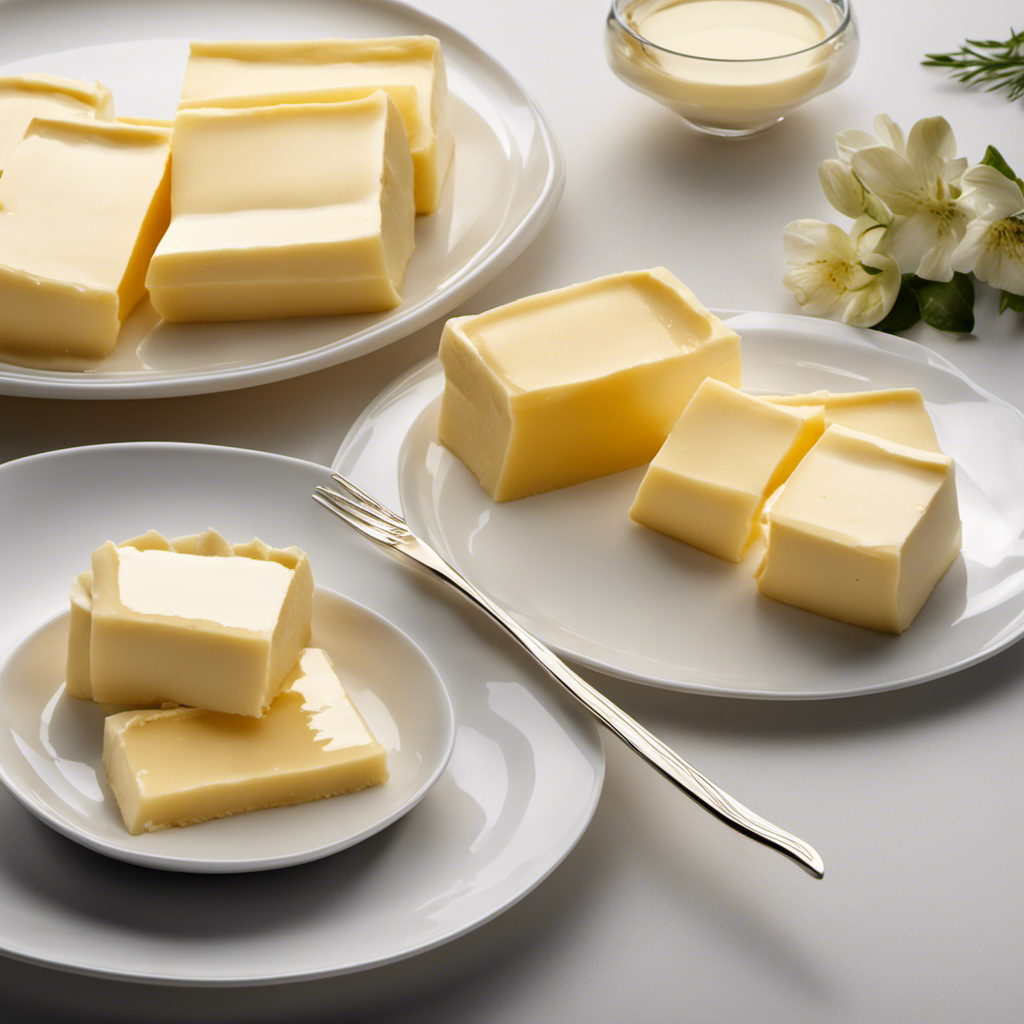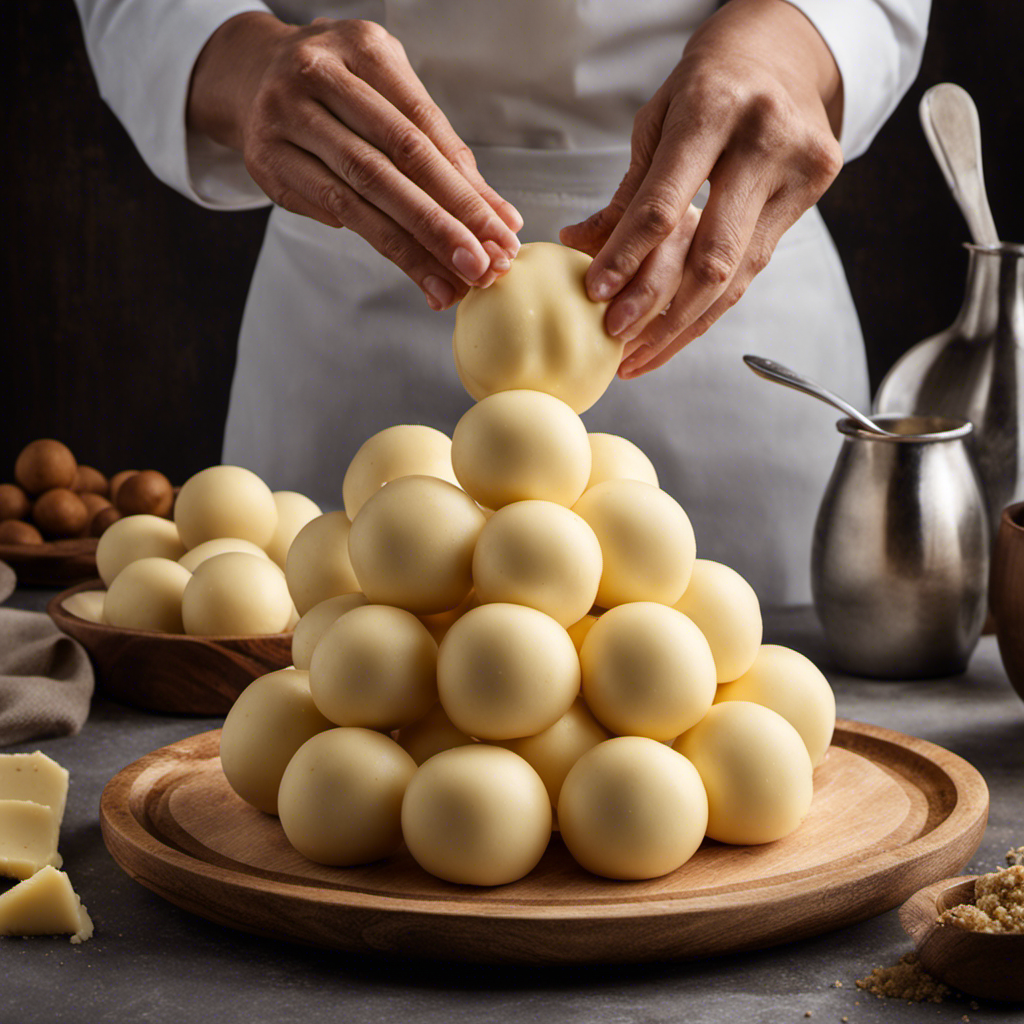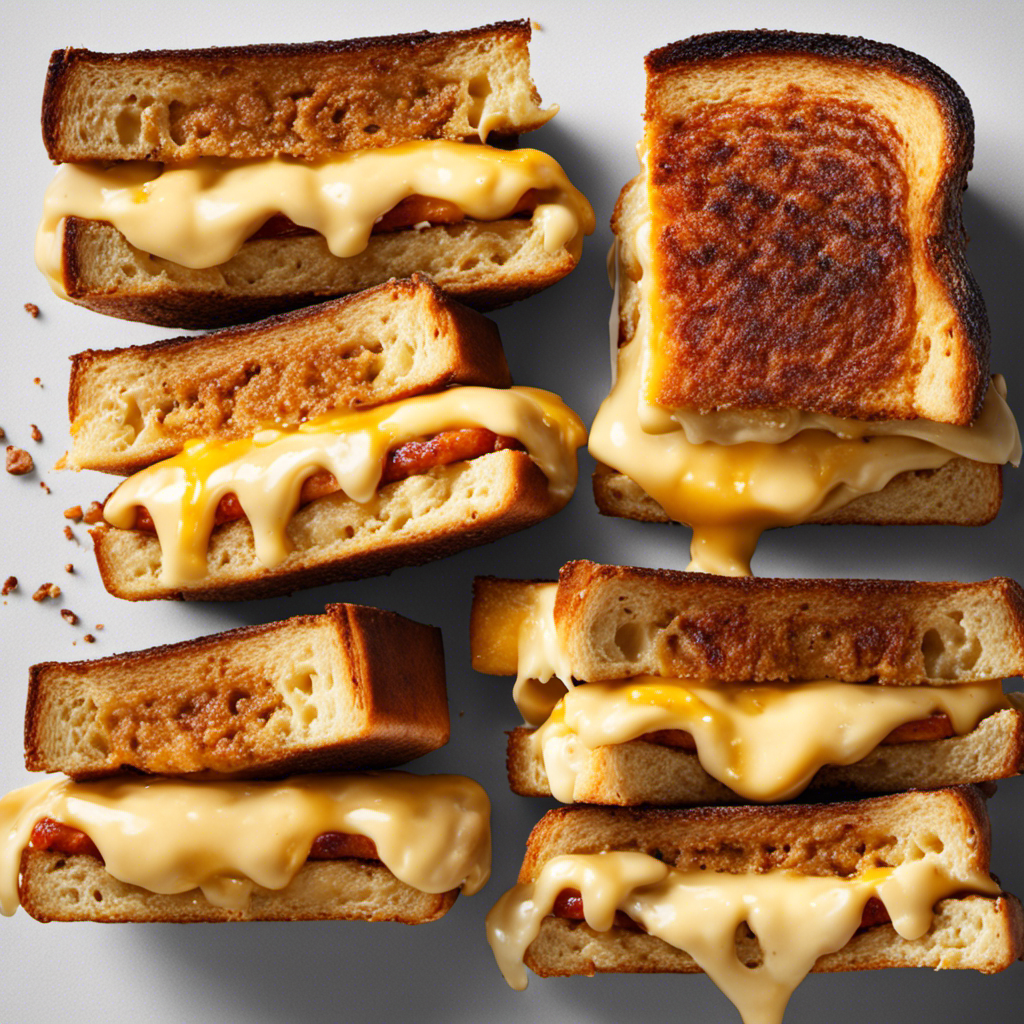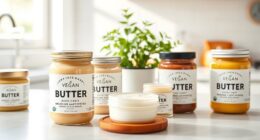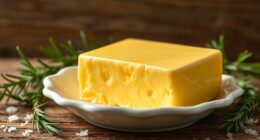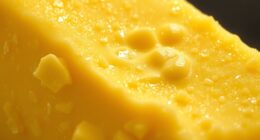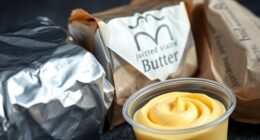I’ve always found it interesting how measuring butter can be so confusing. But don’t worry, my friends, I am here to help solve this culinary puzzle.
In this article, we will tackle the age-old question: how many tablespoons is 8 oz of butter? Prepare to become a master of butter measurements as we explore conversion ratios, kitchen scales, and tips for accurate butter measuring.
Let’s dive in, shall we?
Key Takeaways
- 8 ounces of butter is equivalent to 16 tablespoons or 113 grams.
- Measuring butter in tablespoons is useful for recipes that require butter in cups.
- Converting ounces to tablespoons is crucial for precise measurements in baking.
- Using a kitchen scale is recommended for more accurate results.
Understanding the Conversion Ratio
To understand the conversion ratio, you need to know how many tablespoons are in 8 oz of butter.
When measuring butter in cups, it’s important to have accurate measurements for your recipes. One cup of butter is equal to 8 ounces or 226 grams.
This means that 8 ounces of butter is equivalent to 16 tablespoons or 113 grams.
To convert grams to tablespoons, you can use a simple formula: divide the number of grams by 14.3. So, if you have 113 grams of butter, you would divide 113 by 14.3 to get approximately 7.9 tablespoons.
It’s always a good idea to double-check your conversions and adjust accordingly based on your own preferences and the specific recipe you are following.
Measuring Butter in Tablespoons
You can measure 8 ounces of butter by using tablespoons. It’s a convenient way to ensure accuracy when following a recipe that calls for a specific amount of butter. To help you visualize the conversion, here’s a table that shows the number of tablespoons in different quantities of butter:
| Butter (oz) | Butter (tbsp) |
|---|---|
| 1 | 2 |
| 2 | 4 |
| 4 | 8 |
| 8 | 16 |
As you can see, 8 ounces of butter is equivalent to 16 tablespoons. This information can come in handy, especially if your recipe requires measuring butter in cups. With the help of a butter dish or a measuring cup, you can easily scoop out the desired amount of butter in tablespoons to achieve the perfect balance of flavors in your culinary creation.
Converting Ounces to Tablespoons
Using tablespoons, it’s easy to convert ounces to the appropriate measurement for your recipe. When measuring butter in cups, it’s important to know the conversion from ounces to tablespoons.
One stick of butter is equal to 8 tablespoons or 1/2 cup. Therefore, if you have 8 ounces of butter, you would need 16 tablespoons or 1 cup. This conversion is crucial when baking, as precise measurements can greatly impact the outcome of your baked goods.
However, while tablespoons can be a convenient way to measure butter, they may not always provide the most accurate results. To ensure the utmost accuracy, using a kitchen scale is recommended. A kitchen scale allows you to measure the exact weight of butter, which can be more reliable and consistent for your baking needs.
Using a Kitchen Scale for Accuracy
When measuring ingredients for baking, a kitchen scale provides precise and consistent accuracy. It is especially useful when measuring butter by weight. Here are the benefits of using a kitchen scale:
-
Accuracy:
A kitchen scale allows you to measure ingredients with precision, ensuring your recipes turn out just right. It eliminates the guesswork involved in measuring by volume, which can vary depending on how ingredients are packed. -
Consistency:
Using a kitchen scale ensures that you consistently use the same amount of ingredients, resulting in consistent taste and texture in your baked goods.
Converting Butter Measurements for Recipes
To accurately convert butter measurements in recipes, it’s important to understand the different units of measurement. Butter consistency plays a crucial role in achieving the desired results.
When a recipe calls for a specific amount of butter, it is usually referring to the weight measurement, such as ounces or grams. However, if you don’t have a kitchen scale, you can convert these measurements to tablespoons. One stick of butter is typically equal to 8 tablespoons or 1/2 cup. This can be useful when you need a quick substitute or if your recipe only provides measurements in tablespoons.
It’s also worth knowing that there are alternative butter substitutes available, such as margarine or coconut oil, which can be used in various recipes. Understanding butter consistency and alternative butter substitutes allows for flexibility and creativity in the kitchen.
Tips for Measuring Butter Without a Scale
When it comes to measuring butter without a scale, there are a few tricks I’ve learned along the way.
First, I rely on eyeballing the measurements by comparing the butter to common household items like coins or dice.
Second, I make use of kitchen tools such as measuring spoons or a butter dish with markings to help estimate the amount needed.
Lastly, I’ve discovered some handy butter conversion hacks that can be useful when trying to convert measurements from tablespoons to ounces or vice versa.
Eyeballing Butter Measurements
If you’re trying to eyeball butter measurements, remember that 8 oz is equivalent to 1 cup or 16 tablespoons. Estimating butter quantities can be tricky, but with practice, you can become more accurate. Here are some tips to help you measure butter without a scale:
-
Softened Butter:
-
Slice the butter into tablespoon-sized pieces and pack them tightly into a measuring cup.
-
Use a knife or spatula to level off the top, ensuring an accurate measurement.
-
Cold Butter:
-
Cut the butter into tablespoon-sized chunks and place them side by side in the measuring cup.
-
Again, use a knife or spatula to level off the top, ensuring a precise measurement.
Using Kitchen Tools
Using kitchen tools can greatly simplify the process of measuring ingredients accurately. When it comes to measuring accuracy, alternative methods like eyeballing can lead to inconsistent results. By using tools like measuring cups and spoons, you can ensure that you are adding the right amount of ingredients to your recipe. These tools are designed to provide precise measurements, making it easier to follow recipes and achieve the desired outcome.
Table:
| Kitchen Tool | Purpose |
|---|---|
| Measuring Cups | Used for measuring liquids and dry ingredients. |
| Measuring Spoons | Used for measuring small amounts of liquid or dry ingredients. |
With the help of these tools, you can confidently measure ingredients like butter in tablespoons or ounces. This level of precision can make a significant difference in the final outcome of your dish. So, next time you’re in the kitchen, don’t underestimate the power of kitchen tools in achieving accurate measurements.
Butter Conversion Hacks
To make measuring easier, you can try these butter conversion hacks. Here are some tricks I use to measure butter accurately:
-
Use the tablespoon markings on the butter wrapper: Most butter wrappers have tablespoon measurements marked on the side. Simply cut the butter using the markings to get the desired amount.
-
Use a kitchen scale: A kitchen scale is a precise way to measure butter. Place the butter on the scale and adjust until you reach the desired weight in ounces or grams.
-
Use water displacement method: Fill a measuring cup with water and note the measurement. Add butter to the cup until the water level rises to the desired measurement. The butter displaces the water, giving you an accurate measurement.
-
Use online conversion tools: If you prefer a digital solution, there are many online conversion tools available. Simply input the amount of butter you have or need, and the tool will provide you with the equivalent measurements.
These hacks will ensure you measure butter accurately and achieve the perfect results in your recipes.
Common Mistakes to Avoid in Butter Measurements
When measuring butter, be careful to avoid common mistakes in measurements.
One common mistake is trying to measure butter without a scale. While it is possible to estimate butter quantities using other methods, such as using tablespoons or cups, it can be less accurate. Estimating butter quantities can lead to inconsistent results in recipes, especially when it comes to baking.
To ensure precise measurements, it is recommended to use a kitchen scale specifically designed for measuring butter. This will give you the most accurate and consistent results.
However, if you don’t have a scale and need to estimate, it’s important to know that one stick of butter is equal to 8 tablespoons or 1/2 cup. Keep in mind that this is just an estimate and may vary slightly.
Frequently Asked Questions
Can I Use Margarine Instead of Butter in Recipes That Call for 8 Oz of Butter?
Yes, you can use margarine as a substitute for butter in recipes that call for 8 oz of butter. However, keep in mind that margarine may alter the taste and texture of the dish.
How Many Sticks of Butter Is Equivalent to 8 Oz?
To convert butter measurements, I’ll start by discussing the equivalent measurements. 8 oz of butter is equal to 1 stick of butter. Now, let’s move on to the specific question of how many tablespoons that would be.
Are There Any Substitutes for Butter When Baking?
When baking, there are non-dairy alternatives to butter that can be used. However, it’s important to consider the effects of using different fats. Substitutes like coconut oil or margarine can affect texture and flavor.
How Long Does It Take for 8 Oz of Butter to Soften at Room Temperature?
It usually takes about 30-60 minutes for 8 oz of butter to soften at room temperature. However, keep in mind that the time may vary depending on the temperature and the consistency you desire. As for using margarine instead of butter, yes, you can substitute it in recipes that call for 8 oz of butter. Just make sure to use the same amount and consider that the taste and texture may be slightly different.
Can I Use a Liquid Measuring Cup to Measure 8 Oz of Melted Butter?
Yes, you can use a liquid measuring cup to measure 8 oz of melted butter, but it’s more accurate to use a scale. A regular measuring cup may not give you the exact amount.
Conclusion
So there you have it! Now you know that 8 ounces of butter is equal to 16 tablespoons.
It’s always handy to have this conversion ratio in mind when you’re cooking or baking. Whether you’re following a recipe or experimenting in the kitchen, being able to accurately measure your ingredients is key.
Remember, if you don’t have a kitchen scale, you can still make do with measuring spoons. Just make sure to level off the butter in the tablespoon for the most accurate measurement.
Happy cooking!
